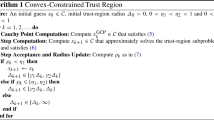Abstract
Existing conjugate gradient (CG)-based methods for convex quadratic programs with bound constraints require many iterations for solving elastic contact problems. These algorithms are too cautious in expanding the active set and are hampered by frequent restarting of the CG iteration. We propose a new algorithm called the Bound-Constrained Conjugate Gradient method (BCCG). It combines the CG method with an active-set strategy, which truncates variables crossing their bounds and continues (using the Polak–Ribière formula) instead of restarting CG. We provide a case with n=3 that demonstrates that this method may fail on general cases, but we conjecture that it always works if the system matrix A is non-negative. Numerical results demonstrate the effectiveness of the method for large-scale elastic contact problems.






Similar content being viewed by others
References
Kalker, J.: Three-Dimensional Elastic Bodies in Rolling Contact. Solid Mechanics and Its Applications. Kluwer Academic, Amsterdam (1990)
Vollebregt, E.: User guide for CONTACT, Vollebregt & Kalker’s rolling and sliding contact model. Tech. Rep. TR09-03. version 13.1, VORtech BV (2013). See www.kalkersoftware.org
Hager, W., Zhang, H.: A new active set algorithm for box constrained optimization. SIAM J. Optim. 17(2), 526–557 (2006)
Moré, J., Toraldo, G.: On the solution of large quadratic programming problems with bound constraints. SIAM J. Optim. 1, 93–113 (1991)
Bertsekas, D.: Nonlinear Programming. Athena Scientific, Belmont (1999)
Nocedal, J., Wright, S.: Numerical Optimization. Springer, New York (2000)
Hestenes, M., Stiefel, E.: Methods of conjugate gradients for solving linear systems. J. Res. Natl. Bur. Stand. 49(6), 409–436 (1952)
Shewchuk, J.: An introduction to the conjugate gradient method without the agonizing pain. Tech. rep., Carnegie mellon University, Pittsburgh, PA, USA (1994)
Barrett, R., Berry, M., Chan, T., Demmel, J., Donato, J., Dongarra, J., Eijkhout, V., Pozo, R., Romine, C., van der Vorst, H.: Templates for the Solution of Linear Systems: Building Blocks for Iterative Methods. SIAM, Philadelphia (1994)
Saad, Y.: Iterative Methods for Sparse Linear Systems, 2nd edn. SIAM, Philadelphia (2003)
Hestenes, M.: Conjugate Direction Methods in Optimization, Applications of Mathematics vol. 12. Springer, New York (1980)
Polyak, B.: The conjugate gradient method in extremal problems. USSR Comput. Math. Math. Phys. 9, 94–112 (1969)
O’Leary, D.: A generalized conjugate gradient algorithm for solving a class of quadratic programming problems. Linear Algebra Appl. 34, 371–399 (1980)
Dembo, R., Tulowitzki, U.: On the minimization of quadratic functions subject to box constraints. Tech. Rep., School of Organization and Management, Yale University, New Haven, CT (1983)
Yang, E., Tolle, J.: A class of methods for solving large convex quadratic programs subject to box constraints. Math. Program. 51, 223–228 (1991)
Birgin, E., Martínez, J.: Large-scale active-set box-constrained optimization method with spectral projected gradients. Comput. Optim. Appl. 22, 101–125 (2002)
Dostál, Z., Schöberl, J.: Minimizing quadratic functions subject to bound constraints with the rate of convergence and finite termination. Comput. Optim. Appl. 30, 23–43 (2005)
Polonsky, I., Keer, L.: A numerical method for solving rough contact problems based on the multi-level multi-summation and conjugate gradients techniques. Wear 231, 206–219 (1999)
Sainsot, P., Lubrecht, A.: Efficient solution of the dry contact for rough surfaces: a comparison of fast Fourier transform and multigrid methods. Proc. Inst. Mech. Eng., Part J J. Eng. Tribol. 225, 441–448 (2011)
Polak, E., Ribière, G.: Note sur la convergence de méthodes de directions conjugées. Rev. Francaise Inform. Rech. Opér. 16, 35–43 (1969)
Press, W., Teukolsky, S., Vetterling, W., Flannery, B.: Numerical Recipes in Fortran 77 The Art of Scientific Computing 2nd edn. Cambridge University Press, Cambridge (1992)
Vollebregt, E.: A Gauss–Seidel type solver for special convex programs, with application to frictional contact mechanics. J. Optim. Theory Appl. 87(1), 47–67 (1995)
HinterMüller, M., Ito, K., Kunisch, K.: The primal-dual active set strategy as a semismooth Newton method. SIAM J. Optim. 13, 865–888 (2003)
Meyer, C.: Matrix Analysis and Applied Linear Algebra. SIAM, Philadelphia (2000)
Vollebregt, E.: A new solver for the elastic normal contact problem using conjugate gradients, deflation, and an FFT-based preconditioner. J. Comput. Phys., Part A 257, 333–351 (2014). doi:10.1016/j.jcp.2013.10.005
Nogi, T., Kato, T.: Influence of a hard surface layer on the limit of elastic contact—Part I: Analysis using a real surface model. ASME J. Tribol. 119, 493–500 (1997)
Webster, M., Sayles, R.: A numerical model for the elastic contact of real rough surfaces. ASME J. Tribol. 108, 314–320 (1986)
Johnson, K.: Contact Mechanics. Cambridge University Press, Cambridge (1985)
Dekking, F., Kalker, J., Vollebregt, E.: Simulation of rough, elastic contacts. J. Appl. Mech. 64, 361–368 (1997)
Vollebregt, E.: Condition and eigenvalues of the elastic normal contact problem. Report EV/M13.003, VORtech BV (2013). Available upon request
Liu, S., Wang, Q.: Studying contact stress fields caused by surface tractions with a discrete convolution and Fast Fourier transform algorithm. ASME J. Tribol. 124, 36–45 (2002)
Acknowledgements
Thanks to my colleagues Jok Tang, Martin van Gijzen, Kees Oosterlee, and Jing Zhao for valuable discussions on this work. Thanks to Jing Zhao for her work on the test problem. Thanks to VORtech (Mark Roest) for supporting this work financially. Thanks also to the reviewers for their comments and suggestions on this work.
Author information
Authors and Affiliations
Corresponding author
Additional information
Communicated by Johannes O. Royset.
Appendix: MATLAB Code
Appendix: MATLAB Code
The Matlab code below implements the Enhanced BCCG algorithm. Plain BCCG is obtained by setting use_plain=1; in the fourth line, the NORM+CG algorithm is obtained when use_normcg=1;.

Rights and permissions
About this article
Cite this article
Vollebregt, E.A.H. The Bound-Constrained Conjugate Gradient Method for Non-negative Matrices. J Optim Theory Appl 162, 931–953 (2014). https://doi.org/10.1007/s10957-013-0499-x
Received:
Accepted:
Published:
Issue Date:
DOI: https://doi.org/10.1007/s10957-013-0499-x




